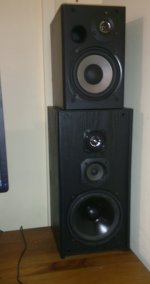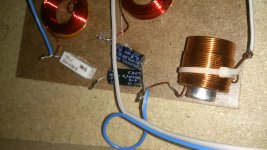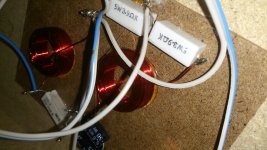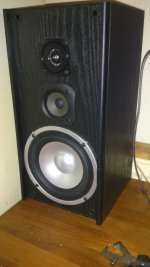I'm still trying to create my ideal desktop system. I have an 8" sub at my feet - it's brilliant, no complaints. What I'm trying to achieve is a system that still sounds acceptable with the sub switched off (neighbours, party wall). I had a pair of Sony SS-CPX1 on my desk - it was all working. But then I bought a pair of Goodmans HT-97s for £2. Bigger driver, bigger cabinet . . . more bass, right?
No. The Sonys (top) produce more bass but the Goodmans tweeters are loud and harsh but sweet. I'll guess 5 or 6 dB above the Sonys - my ears are ringing. These are very old speakers. Could it be a cross-over issue?
I'm minded to put the Goodmans tweeters in the Sonys and ditch the rest. But I don't want to be told that HT-97s were really great speakers back in the day . . . and I just threw a pair in a skip.
No. The Sonys (top) produce more bass but the Goodmans tweeters are loud and harsh but sweet. I'll guess 5 or 6 dB above the Sonys - my ears are ringing. These are very old speakers. Could it be a cross-over issue?
I'm minded to put the Goodmans tweeters in the Sonys and ditch the rest. But I don't want to be told that HT-97s were really great speakers back in the day . . . and I just threw a pair in a skip.
Attachments
I can't find any information on the Goodmans HT-97. Have you found any?
I don't understand how "harsh" and "sweet" can be used to describe the same tweeter.
Look for the presence of a tweeter attenuating resistor in the HT-97 crossover and increase its value to taste - or introduce one if none is present in the first place.
P.S. Swapping tweeters between the two models of speakers is dabbling with disaster!
the Goodmans tweeters are loud and harsh but sweet. I'll guess 5 or 6 dB above the Sonys ... Could it be a cross-over issue?
I don't understand how "harsh" and "sweet" can be used to describe the same tweeter.

Look for the presence of a tweeter attenuating resistor in the HT-97 crossover and increase its value to taste - or introduce one if none is present in the first place.
P.S. Swapping tweeters between the two models of speakers is dabbling with disaster!
I can't find any information on the Goodmans HT-97. Have you found any?
I don't understand how "harsh" and "sweet" can be used to describe the same tweeter.
Look for the presence of a tweeter attenuating resistor in the HT-97 crossover and increase its value to taste - or introduce one if none is present in the first place.
P.S. Swapping tweeters between the two models of speakers is dabbling with disaster!
Attachments
Sorry, the crossover contains two capacitors, three resistors, and and three coils. The nominal impedance of the unit is 4ohms. It all seems a little strange. Why so many resistors and the speaker is so bright?Have you forgotten to add some text?
Resistors in crossovers can have functions other than attenuation. It's also possible that a resistor is being used to attenuate the midrange driver.
Sometimes two resistors (one in series with the driver and one in parallel) are used to provide attenuation (an L pad arrangement).
Try to identify which resistor or resistors is/are associated with the tweeter.
I can't see the full board face on in your photographs and you haven't identified which wires go where, making it difficult to trace the circuit.
Sometimes two resistors (one in series with the driver and one in parallel) are used to provide attenuation (an L pad arrangement).
Try to identify which resistor or resistors is/are associated with the tweeter.
I can't see the full board face on in your photographs and you haven't identified which wires go where, making it difficult to trace the circuit.
I'm minded to put the Goodmans tweeters in the Sonys and ditch the rest.
Whatever you do, don't risk spoiling the sound of your Sony speakers (which you're happy with) by replacing their tweeters with the ones from the Goodmans speakers.
Best left as is I would say!
If you are now concentrating on reducing the level of the tweeters in the Goodmans, then fair enough.
In fact, reducing the treble (and perhaps midrange) level may to allow the bass (which you currently find lacking) to shine through.
EDIT: I presume the bass drivers in the Goodmans speakers are operatiing properly?
The Sonys remain intact. It's fun, messing around with spare parts. I'm more interested in producing 'the sound I like' rather than a flat frequency response. Replaced the woofers, a little more bass extension but still sounding too sharp. My next plan (spares available) is to replace the 4.7mf capacitors with 3.3.Whatever you do, don't risk spoiling the sound of your Sony speakers (which you're happy with) by replacing their tweeters with the ones from the Goodmans speakers.
Best left as is I would say!
If you are now concentrating on reducing the level of the tweeters in the Goodmans, then fair enough.
In fact, reducing the treble (and perhaps midrange) level may to allow the bass (which you currently find lacking) to shine through.
EDIT: I presume the bass drivers in the Goodmans speakers are operating properly?
What do you think?
Attachments
What do you think?
Without a crossover schematic it is difficult to know what to think! Where's the required crossover photo/wiring information?
Why aren't you looking to the attenuation resistor(s) as I suggested?
The single resistor (bottom pic1) was attached to tweeter. But the crossover board is glued to the side panel and difficult to work on. The problem ended up being the Westra tweeters. Even with the resistor they were super loud, out of balance with other drivers.Without a crossover schematic it is difficult to know what to think! Where's the required crossover photo/wiring information?
Why aren't you looking to the attenuation resistor(s) as I suggested?
I'm not good with crossovers. I know the least driver resistance is at the bottom of the frequency range but the rest is confusing to me. e.g. The tweeter was 8ohms + 4 ohm resistor.
Anyway, thanks for your help. The sound is much improved.
If there is a 4 ohm resistor in series with your 8 ohm tweeter, then adding an 8 ohm resistor in parallel with your tweeter (i.e. across its terminals) will give you additional attenuation while maintaining an overall 8 ohm load for the crossover. A total attenuation of 6 dB will be achieved - around double what you had before.
If there is a 4 ohm resistor in series with your 8 ohm tweeter, then adding an 8 ohm resistor in parallel with your tweeter (i.e. across its terminals) will give you additional attenuation while maintaining an overall 8 ohm load for the crossover. A total attenuation of 6 dB will be achieved - around double what you had before.
Again, thanks. In the end I had some Mylar tweeters lying around. The result is a 6 ohm cabinet that sounds a little like old Wharfedale XPs. I'll save the Westra tweeters for a larger cabinet. The could probably keep up with a pair of 8" in a two-way cabinet,
- Home
- Loudspeakers
- Multi-Way
- Goodmans HT-97 and other questions.



